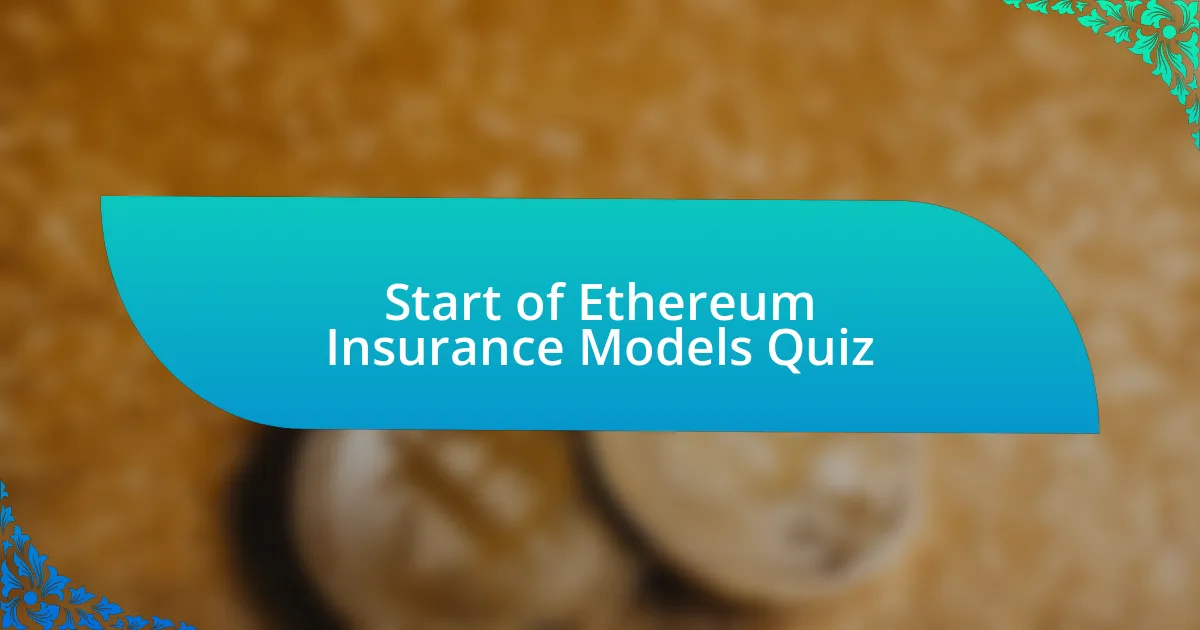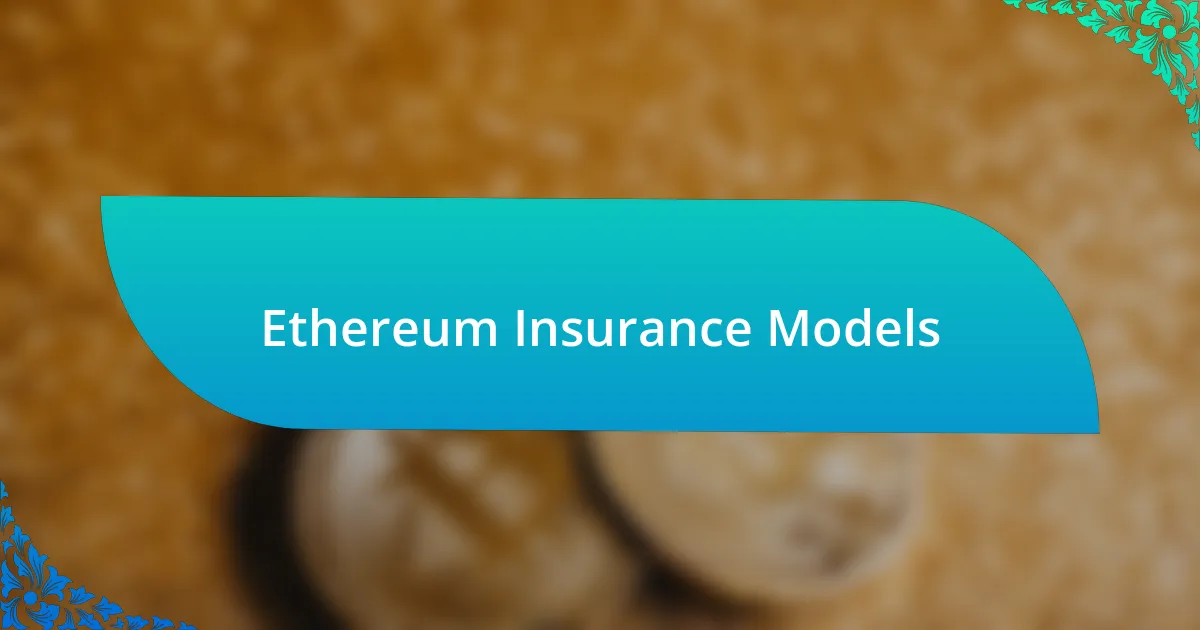
Start of Ethereum Insurance Models Quiz
1. What is Ethereum?
- Ethereum is a social media platform designed for sharing artwork and photography.
- Ethereum is a cryptocurrency used exclusively for online gaming and digital collectibles.
- Ethereum is a type of cloud storage service primarily for data backups and file sharing.
- Ethereum is a second-generation distributed ledger technology that builds upon the Bitcoin network, launched in 2015, and is an open-source public distributed ledger technology with key features such as smart contracts and transaction-based state transitions.
2. Who are the original authors of Ethereum?
- Charles Hoskinson and Vitalik Buterin
- Vitalik Buterin and Gavin Wood
- Satoshi Nakamoto and Changpeng Zhao
- Andreas Antonopoulos and Justin Sun
3. What is the Ethereum Virtual Machine (EVM)?
- The Ethereum Virtual Machine (EVM) is a mobile app developed for Ethereum users to manage their tokens and transactions securely.
- The Ethereum Virtual Machine (EVM) is a centralized database that supports transaction processing and ledger management for private users.
- The Ethereum Virtual Machine (EVM) is a coding language designed for smart contracts, focusing solely on transaction verification methods.
- The Ethereum Virtual Machine (EVM) is a decentralized virtual machine capable of handling scripts using the public nodes network, and it is Turing complete, utilizing Gas as an internal pricing mechanism.
4. What is the value token for Ethereum?
- Litecoin (LTC)
- Ether (ETH)
- Ripple (XRP)
- Bitcoin (BTC)
5. What is Ether?
- Ether is a physical currency used in online transactions.
- Ether is a type of digital wallet used for storing cryptocurrencies.
- Ether is a crypto-fuel token that powers the Ethereum network.
- Ether is a programming language for creating decentralized applications.
6. Which consensus algorithm does Ethereum use?
- Delegated Proof-of-Stake
- Byzantine Fault Tolerance
- Proof-of-Work
- Proof-of-Stake
7. What are smart contracts?
- Smart contracts are physical contracts signed in traditional ways by the parties involved.
- Smart contracts are encrypted emails exchanged to establish contractual obligations.
- Smart contracts are paper agreements that require notarization to become valid.
- Smart contracts are self-executing contracts with the terms of the agreement written directly into lines of code, which can be deployed on the Ethereum blockchain.
8. What is the purpose of the NXM token in Nexus Mutual?
- The NXM token is solely for funding startup projects in the DeFi space.
- The NXM token is used exclusively for trading on crypto exchanges.
- The NXM token in Nexus Mutual is used for governance, purchasing cover, and voting on claims.
- The NXM token serves as a reward for staking on other platforms.
9. What types of risks can customers insure against on Nexus Mutual?
- Customers can insure against health issues, life insurance, and travel cancellations.
- Customers can insure against weather events, personal injuries, and disability claims.
- Customers can insure against yield token loss, protocol failures, and hacks or halted withdrawals on exchanges or custodial wallets.
- Customers can insure against car accidents, fire damages, and theft of physical property.
10. How do customers pay for insurance on Nexus Mutual?
- Customers can use Bitcoin or Litecoin directly for insurance.
- Customers pay with cash or credit cards for cover and claims.
- Customers must purchase a physical voucher for insurance coverage.
- Customers pay in ETH or DAI to buy cover, which converts to NXM.
11. What happens if a customer suffers a loss and files a claim on Nexus Mutual?
- Customers receive instant payments regardless of review.
- NXM holders must pay out of pocket for claims.
- Claim assessors determine the outcome based on stakes.
- Claims are automatically approved without review.
12. What is the role of Incentivai in Nexus Mutual?
- Incentivai is an insurance underwriting agency that processes claims for Nexus Mutual.
- Incentivai is a data analytics platform that sells user information to third parties.
- Incentivai is a financial advisory service that manages insurance policies for clients.
- Incentivai is a machine learning algorithm that checks user behavior to determine whether an act is fraudulent, helping the advisory board of Nexus Mutual make decisions.
13. What is the purpose of the cover pools in Nexus Mutual?
- The cover pools in Nexus Mutual serve as a savings account for users to grow their NXM holdings.
- The cover pools in Nexus Mutual provide compensation to claimants when insured events occur, funded by staked NXM tokens.
- The cover pools in Nexus Mutual are used to reward advisors for managing customer accounts.
- The cover pools in Nexus Mutual serve as an investment fund for purchasing cryptocurrencies.
14. What is the difference between Dedicated Covers and Diversified Covers on Neptune Mutual?
- Dedicated Covers cover all cryptocurrencies, while Diversified Covers focus solely on Bitcoin.
- Dedicated Covers are short-term contracts, while Diversified Covers are long-term agreements.
- Dedicated Covers are tailor-made policies for specific communities, while Diversified Covers spread risk across multiple projects.
- Dedicated Covers are available for individuals only, while Diversified Covers are for corporations only.
15. What types of insurance covers does Neptune Mutual offer?
- Auto and Home Insurance
- Travel and Pet Insurance
- Life and Health Insurance
- Dedicated Covers and Diversified Covers
16. How does Neptune Mutual handle insurance claims?
- Neptune Mutual requires extensive documentation and proof before processing any insurance claims.
- Neptune Mutual denies all claims unless physical damage can be demonstrated.
- Neptune Mutual handles insurance claims by allowing users to collect stablecoin payouts immediately without providing personally identifiable information or evidence of loss.
- Neptune Mutual settles claims only through traditional banking methods, involving lengthy approvals.
17. What is the purpose of the $INSUR token in InsurAce?
- The $INSUR token in InsurAce is used to govern the risk-sharing pools and manage the underwriting and claim assessment processes.
- The $INSUR token in InsurAce is dedicated to staking rewards only.
- The $INSUR token in InsurAce is primarily for trading on exchanges.
- The $INSUR token in InsurAce is used to purchase insurance directly.
18. What types of risks does InsurAce cover?
- InsurAce covers natural disasters and property damage.
- InsurAce covers smart contract vulnerabilities, custodian risks, and stablecoin depegging risks.
- InsurAce covers user data theft and phishing attacks.
- InsurAce covers vehicle accidents and health issues.
19. How does InsurAce operate its mutual model?
- InsurAce operates its mutual model through exclusive partnerships, offering risk coverage dictated by corporate rules rather than community governance.
- InsurAce operates its mutual model by solely relying on private insurance claims that are settled without community involvement.
- InsurAce operates its mutual model by sharing risk in two pools: the cover payment pool and the underwriting mining pool, governed by the community through the $INSUR token.
- InsurAce operates its mutual model using a single pool managed by centralized authorities for risk distribution.
20. What is the purpose of the Insurance Liquidity feature on Bright Union?
- The Insurance Liquidity feature allows users to earn stable yields on DAI.
- The Insurance Liquidity feature does not support cryptocurrency assets.
- The Insurance Liquidity feature increases transaction fees on DAI.
- The Insurance Liquidity feature provides unlimited insurance coverage.
21. What services does Bright Union offer?
- Bright Union provides only asset management and investment services.
- Bright Union specializes in conventional insurance policies and financial planning.
- Bright Union offers Insurance Liquidity, Aggregator, and Integrator services.
- Bright Union focuses solely on cryptocurrency trading and exchanges.
22. What is the Aggregator service on Bright Union?
- Provides a platform for high-speed trading of cryptocurrencies.
- Offers educational resources for crypto beginners.
- Functions as a wallet service for storing digital assets.
- Enables users to insure crypto assets against various DeFi risks.
23. What is the Integrator service on Bright Union?
- The Integrator service on Bright Union allows users to track insurance market trends in real-time.
- The Integrator service on Bright Union provides automated risk assessment for insurance claims.
- The Integrator service on Bright Union helps users create custom insurance policies for their businesses.
- The Integrator service on Bright Union allows developers to integrate insurance products into any app or wallet with just three lines of code.
24. What is parametric insurance on the Ethereum blockchain?
- Parametric insurance on the Ethereum blockchain is an automated insurance scheme where compensation is triggered by predefined conditions, such as specific events or metrics.
- Parametric insurance on the Ethereum blockchain is solely focused on life insurance policies.
- Parametric insurance on the Ethereum blockchain requires extensive documentation for each claim filed.
- Parametric insurance on the Ethereum blockchain involves traditional policy underwriting by agents and brokers.
25. How does the collaborative aspect work in parametric insurance on the Ethereum blockchain?
- The collaborative aspect is embodied in the generation of tokens, which are distributed to both surplus providers and policyholders, representing each participant’s share of the surplus and granting voting rights for management decisions.
- The collaborative aspect is focused on controlling all operations through a centralized authority that makes unchallenged decisions for the participants.
- The collaborative aspect utilizes a referral system where users can earn bonuses for bringing in new clients, thereby fostering competition among policyholders.
- The collaborative aspect relies on manual assessments by insurance agents to approve claims and determine payouts, ensuring a personal touch in the process.
26. What are the key participants in a blockchain-based insurance scheme?
- The key participants are the claim assessors, beneficiaries, and appraisers.
- The key participants are the insurers, brokers, and regulators.
- The key participants are the smart contract owner, investors, and policyholders.
- The key participants are the auditors, underwriters, and customers.
27. What is the role of the smart contract owner in a blockchain-based insurance scheme?
- The smart contract owner only manages user accounts and wallets.
- The smart contract owner designs the insurance protocol and sets parameters.
- The smart contract owner is responsible for customer service and support.
- The smart contract owner collects premiums and distributes payouts manually.
28. How do investors participate in a blockchain-based insurance scheme?
- Investors participate by locking funds in the smart contract in exchange for protocol tokens.
- Investors buy insurance policies using traditional currencies.
- Investors act as underwriters and evaluate claims directly.
- Investors receive dividends based solely on market performance.
29. What is the purpose of the premium loading in a blockchain-based insurance scheme?
- The premium loading is solely for marketing expenses and advertising.
- The premium loading only compensates policyholders for claims.
- The premium loading covers management costs and invests in returns.
- The premium loading is reserved exclusively for regulatory compliance fees.
30. How does the tokenization of risk work in a blockchain-based insurance scheme?
- The tokenization of risk involves distributing tokens to participants, representing their share of the surplus, which grants voting rights and incentivizes positive behavior in the network.
- The tokenization of risk relies solely on centralized authorities to manage transactions and claims in the network.
- The tokenization of risk is focused only on traditional methods of insurance without the use of blockchain technology.
- The tokenization of risk prohibits participants from having any voting rights or sharing in the surplus generated from their contributions.

Congratulations on Completing the Quiz!
You’ve successfully completed the quiz on Ethereum Insurance Models! We hope you enjoyed the process and found it enlightening. This topic is increasingly relevant, as Ethereum continues to shape the future of decentralized finance and insurance.
Throughout the quiz, you may have discovered how Ethereum-based insurance works, the advantages it offers, and the potential challenges it faces. Understanding these concepts is vital for anyone interested in blockchain technologies and their applications in risk management.
To deepen your knowledge further, we invite you to explore the next section on this page. It provides comprehensive information on Ethereum Insurance Models, enhancing what you’ve already learned. Dive in and expand your understanding of this innovative field!

Ethereum Insurance Models
Understanding Ethereum and Its Smart Contracts
Ethereum is a decentralized platform that enables developers to build decentralized applications (dApps) using smart contracts. Smart contracts are self-executing agreements, where the terms are written into code. This underlying technology allows for trustless transactions and automated processes. Their code runs on the Ethereum blockchain, ensuring transparency and security. Because of these features, Ethereum is a prime candidate for innovative insurance solutions.
Types of Insurance Models on Ethereum
Ethereum offers various insurance models, including peer-to-peer, parametric, and mutual insurance. Peer-to-peer models connect individuals directly, minimizing traditional insurance intermediaries. Parametric insurance pays out upon the occurrence of predefined events, like natural disasters. Mutual insurance allows members to pool resources, collective risk sharing, which enhances community support. These models leverage Ethereum’s smart contracts for automation and transparency.
Decentralized Insurance Protocols
Decentralized insurance protocols utilize Ethereum’s blockchain to offer insurance without centralized control. Protocols like Nexus Mutual and Cover Protocol exemplify this trend. They use smart contracts to manage claims and payouts efficiently. Users can purchase coverage in a trustless environment, reducing fraud and administrative costs. This model enhances accessibility and user empowerment through decentralized governance.
Challenges in Implementing Ethereum Insurance Models
Implementing insurance models on Ethereum faces several challenges. Regulatory uncertainty poses risks, as many jurisdictions lack clear guidelines for crypto-based insurance. Additionally, smart contract vulnerabilities can lead to exploits that compromise funds. User adoption remains another hurdle; many potential users are unfamiliar with blockchain technologies. Addressing these challenges is crucial for the sustainable growth of Ethereum-based insurance solutions.
The Future of Ethereum Insurance Models
The future of Ethereum insurance models looks promising, driven by technological advancements and increasing mainstream acceptance of blockchain technology. Innovations in oracle solutions may improve real-world data incorporation, enhancing parametric insurance offerings. Furthermore, regulatory clarity could foster growth, attracting traditional insurers to explore blockchain integrations. As awareness and education around Ethereum insurance models grow, the landscape may evolve to support broader usage and development.
What are Ethereum Insurance Models?
Ethereum Insurance Models refer to decentralized insurance mechanisms built on the Ethereum blockchain. These models leverage smart contracts to automate claims processing and payouts, reducing the need for intermediaries. For example, Nexus Mutual offers a coverage model based on community contributors sharing risk, with policies verified by smart contracts to ensure transparency and efficiency.
How do Ethereum Insurance Models work?
Ethereum Insurance Models function through smart contracts that govern the terms of insurance policies. Users purchase coverage by sending Ether to a smart contract, which then manages the gathered funds. When claims arise, they are submitted to the smart contract, which evaluates them based on predefined criteria and automates payment if met. This mechanism enhances trust and reduces processing times compared to traditional insurance.
Where can Ethereum Insurance Models be accessed?
Ethereum Insurance Models can be accessed through decentralized finance (DeFi) platforms and specialized insurance protocols like Nexus Mutual or InsurAce. Users typically need a digital wallet compatible with Ethereum to interact with these platforms, allowing them to buy coverage or participate in risk-sharing pools directly on the blockchain.
When were Ethereum Insurance Models first developed?
Ethereum Insurance Models began to emerge shortly after the launch of the Ethereum blockchain in 2015. The first notable project was Nexus Mutual, launched in 2019, which offered decentralized coverage for smart contracts. Since then, various other projects have developed their models, expanding the landscape of decentralized insurance.
Who benefits from Ethereum Insurance Models?
Several stakeholders benefit from Ethereum Insurance Models, including policyholders, who gain access to potentially lower-cost insurance with greater transparency. Additionally, insurance providers within the ecosystem, such as Nexus Mutual members, share in the profits generated from pooled funds. Furthermore, developers benefit by creating new opportunities in the DeFi insurance market.

